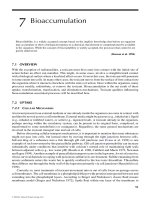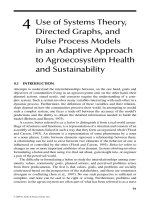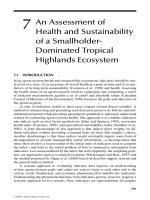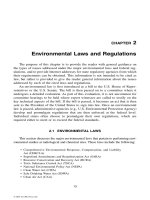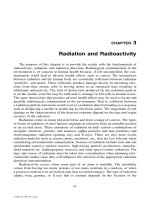SAMPLING AND SURVEYING RADIOLOGICAL ENVIRONMENTS - CHAPTER 7 ppt
Bạn đang xem bản rút gọn của tài liệu. Xem và tải ngay bản đầy đủ của tài liệu tại đây (128.57 KB, 11 trang )
291
CHAPTER
7
Radiological Data Management
The purpose of sampling and surveying in radiological environments is to gen-
erate data. Sampling and Analysis Plans focus on specifying how data will be
generated, and to a lesser extent how they will be used. Less attention is typically
paid to how data will be managed during fieldwork and after fieldwork is completed.
The lack of a data management system and a detailed data management plan can
severely impact the effectiveness of sampling and surveying efforts. For complex
settings that involve multiple sampling programs across a site (or over time), inte-
grating, managing, and preserving information garnered from each of these sampling
programs may be crucial to the overall success of the characterization and remedi-
ation effort.
Environmental data management systems comprise the hardware, software, and
protocols necessary to integrate, organize, manage, and disseminate data generated
by a sampling and analysis program. Data management plans describe how an
environmental data management system will be used to address the data management
needs of sampling and analysis programs. This chapter reviews the objectives of
data management programs, describes the components of a typical data management
system, and discusses data management planning for successful radiological data
management programs.
7.1 DATA MANAGEMENT OBJECTIVES
Radiological data management serves two basic objectives. The first is to ensure
that data collected as part of sampling and surveying programs are readily available
to support the site-specific decisions that must be made. The second is to preserve
information in a manner that ensures its usefulness in the future and satisfies regu-
latory requirements for maintaining a complete administrative record of activities at
a site. These two objectives impose very specific and at times contradictory require-
ments on data management plans and systems.
© 2001 by CRC Press LLC
292 SAMPLING AND SURVEYING RADIOLOGICAL ENVIRONMENTS
7.1.1 Decision Support
Data management for decision making has the following requirements. Decision
making requires the integration of information from sources that will likely go
beyond just the data generated by a sampling and survey program. Decision making
often focuses on derived information rather than the raw data itself. Decision making
demands timely, decentralized, and readily accessible data sets.
For radiologically contaminated sites, decision making requires integrating spa-
tial data from a wide variety of data sources. Examples of these data include:
• Maps that show surface infrastructure, topography, and hydrology. These maps
would likely come from a variety of sources, such as the U.S. Geological Survey
(USGS) or site facility management departments.
• Historical and recent aerial photography. This may include flyover gross gamma
measurement results for larger sites.
• Borehole logs from soil bores and monitoring wells in the area. These logs might
include a wide variety of information, including soil or formation type, moisture
content, depth to the water table, and results from soil core or downhole radiological
scans.
• Nonintrusive geophysical survey data from techniques such as resistivity, ground
penetrating radar, magnetics, etc.
• Surface gross gamma activity scans collected by walk- or driveovers. These data
may have matching coordinate information obtained from a Global Positioning
System, or perhaps may only be assigned to general areas.
• Data from direct in situ surface measurements using systems such as high-purity
germanium gamma spectroscopy.
• Results from traditional soil and water sample analyses.
These data are likely to come in a variety of formats, including simple ASCII
files, databases, spreadsheets, raster image files, electronic mapping layers, hard-
copy field notebooks, and hard-copy maps. All of these data contribute pieces to the
overall characterization puzzle.
Decision making often focuses on information that is a derived from the basic
data collected as part of sampling and survey programs. For example, in estimating
contaminated soil volumes, the decision maker may be primarily interested in the
results of interpolations derived from soil sampling results, and not in the original
soil sampling results themselves. For final status survey purposes, the statistics
derived from a MARSSIM-style analysis may be as important as the original data
used to calculate those statistics. In the case of nonintrusive geophysical surveys, the
final product is often a map that depicts a technician’s interpretation of the raw data
that were collected. Decision making may also require that basic information be
manipulated. For example, outlier or suspect values may be removed from an analysis
to evaluate their impacts on conclusions. Results from alpha spectroscopy might be
adjusted to make them more directly comparable to gamma spectroscopy results.
Timely and efficient decision making presumes that sampling and survey results
are quickly available to decision makers wherever those decision makers may be
located. Off-site analyses for soil samples often include a several-week turnaround
© 2001 by CRC Press LLC
RADIOLOGICAL DATA MANAGEMENT 293
time. When quality assurance and quality control (QA/QC) requirements are imposed
as well, complete final data sets produced by a sampling and survey program might
not be available for months after the program has completed its fieldwork. In many
cases, decisions are required before these final data sets are available. For example,
in a sequential or adaptive sampling program, additional sample collection and the
placement of those samples are based on results from prior samples. In a soil
excavation program, back-filling requirements may demand that final status survey
conclusions be drawn long before final status closure documentation is available.
Site decision makers may be physically distributed as well. For example, the deci-
sion-making team might include staff on site, program management staff in home
offices, off-site technical support contractors, and off-site regulators.
7.1.2 Preserving Information
Preserving, or archiving, sampling and survey results imposes a completely dif-
ferent set of requirements on data management. Data preservation emphasizes com-
pleteness of data sets and documentation. Data preservation focuses primarily on raw
data and not derived results. Data preservation presumes a centralized repository for
information, controlled access, and a very limited ability to manipulate the informa-
tion that is stored. Environmental data archiving systems can become relatively
complex, including a combination of sophisticated database software, relational data-
base designs, and QA/QC protocols governing data entry and maintenance.
7.2 RADIOLOGICAL DATA MANAGEMENT SYSTEMS
Radiological data management systems include the hardware, software, and
protocols necessary to integrate, organize, manage, and disseminate data generated
by a sampling and analysis program. The particulars of any given data management
system are highly site and program specific. However, there are common components
that appear in almost all systems. These components include relational databases
for storing information and software for analyzing and visualizing environmental
data stored in databases.
7.2.1 Relational Databases
Relational databases are the most common means for storing large volumes of
radiological site characterization data. Examples of commercially available relational
database systems include Microsoft’s Access™ , SQL Server™ , and Oracle™ . The
principal differences between commercial products are the presumed complexity of
the application that is being developed and the number of users that will be supported.
For example, Access is primarily a single-user database package that is relatively
easy to configure and use on a personal computer. In contrast, Oracle is an enterprise
system demanding highly trained staff to implement and maintain, but capable of
supporting large amounts of information and a large number of concurrent users
within a secure environment.
© 2001 by CRC Press LLC
294 SAMPLING AND SURVEYING RADIOLOGICAL ENVIRONMENTS
Relational databases store information in tables, with tables linked together by
common attributes. For example, there may be one table dedicated to sampling
station (locations where samples are collected) data, one to sample information, and
one to sample results. Individual rows of information are commonly known as
records, while columns are often referred to as data fields. For example, each record
in a sampling stations table would correspond with one sampling station. The fields
associated with this record might include the station identifier, easting, northing, and
elevation. In the samples table, each record would correspond to one sample. Com-
mon fields associated with a sample record might include station identifier, sample
identifier, depth from sampling station elevation, date of sample, and type of sample.
The results table would contain one record for each result returned. Common fields
associated with a result record might include sample identifier, analyte, method,
result, error, detection limits, QA/QC flag, and date of analysis. Records in the results
table would be linked to the sample table by sample identifier. The sample table
would be linked back to the stations table by a station identifier.
7.2.2 Radiological Data Analysis and Visualization Software
While relational databases are very efficient and effective at managing and
preserving large volumes of environmental data, they do not lend themselves to data
analysis or visualization. Consequently, radiological data management systems also
include software that allow data to be analyzed and visualized. In most cases,
relational databases are most aligned with the goals of preserving information and
so tend to be centralized systems with limited access. In contrast, data analysis and
visualization is most commonly associated with decision support activities. Conse-
quently, these software are usually available on each user’s computer, with the exact
choice and combination of software user specific.
Data analysis software includes a wide variety of packages. For example, spread-
sheets can be used for reviewing data and performing simple calculations or statistics
on data sets. Geostatistical analyses would demand specialized and more-sophisti-
cated software such as the EPA GeoEAS, the Stanford GSLIB, or similar packages.
Analysis involving fate-and-transport calculations could require fate-and-transport
modeling codes. The U.S. Army Corps of Engineers Groundwater Modeling System
(GMS) software is an example of a fate-and-transport modeling environment.
There are also a wide variety of data visualization packages that can be applied
to radiological data. Since most environmental data are spatial (i.e., have coordinates
associated with them), Geographical Information Systems (GIS) can be used. Exam-
ples of commercial GIS software include ArcInfo™ , ArcView™ , MapInfo™ , and
Intergraph™ products. GIS systems are particularly effective at handling large vol-
umes of gamma walkover data. Most GIS systems focus on two-dimensional maps
of spatial information. However, radiological contamination often includes the sub-
surface or vertical dimension as well. Specialized packages such as Dynamic
Graphic’s EarthVision™ product, SiteView™ , and GISKey™ allow some capabil-
ities for three-dimensional modeling and visualization as well. Most of these pack-
ages require a significant amount of experience to use them effectively, but are
© 2001 by CRC Press LLC
RADIOLOGICAL DATA MANAGEMENT 295
invaluable for making sense out of diverse sets of data associated with a radiological
characterization program.
7.3 DATA MANAGEMENT PLANNING
Sampling and survey data collection programs should include a formal data
management plan. For large sites, an overarching data management plan may already
be in place, with individual sampling and analysis plans simply referencing the
master data management plan, calling out project-specific requirements where nec-
essary. For smaller sites, a project-specific data management plan may be an impor-
tant supporting document to the sampling and analysis plan.
The data management plan should include the following components:
• Identify decisions that will use information garnered from the sampling and sur-
veying effort.
• Identify data sources expected to be producing information:
— Link to decision that must be made;
— Define meta-data requirements for each of these data sources;
— Develop data delivery specifications;
— Specify QA/QC requirements;
— Establish standard attribute tables;
— Identify preservation requirements.
• Specify how disparate data sets will be integrated:
— Specify master coordinate system for the site;
— Identify organizational scheme for tying data sets together.
• Specify data organization and storage approaches, including points of access and
key software components.
• Provide data flowcharts for overall data collection, review, analysis, and preservation.
7.3.1 Identify Decisions
One goal of data collection is to support decisions that must be made. If the
EPA Data Quality Objective (DQO) approach was used for designing data collection
(see Section 4.1.1), these decisions should have already been explicitly identified,
and the decision points identified in the data management plan should be consistent
with these. Avoid general decision statements. The identification of decision points
should be as detailed and complete as possible. This is necessary to guarantee that
the overall data management strategy will support the data needs of each decision
point. Each decision point should have its unique data needs. Again, if the EPA
DQO process is followed, these data needs should already be identified and the data
management plan need only be consistent with these.
7.3.2 Identify Sources of Information
The purpose of sampling and surveying data collection programs is to provide
the information that will feed the decision-making process. The data management
© 2001 by CRC Press LLC
296 SAMPLING AND SURVEYING RADIOLOGICAL ENVIRONMENTS
plan needs to identify each of the sources of information. The obvious sources of
data are results from physical samples that are collected and analyzed. Less obvious
but often just as important are secondary sources of information directly generated
by field activities. These may include results from nonintrusive geophysical surveys,
gross activity screens conducted over surfaces, civil surveys, stratigraphic informa-
tion from soil cores and bore logs, downhole or soil core scans, and air-monitoring
results. These may also include tertiary sources of information, data that already
exist. Examples of these data include USGS maps, facility maps of infrastructure
and utilities, and aerial photographs. Finally, sources of information may include
derived data sets. Examples of derived data sets include flow and transport modeling
results, interpretations of nonintrusive geophysical data, rolled-up statistical sum-
maries of raw data, and results from interpolations.
For each source of data, the data management plan should specify what meta-
data need to accompany raw results and who has responsibility for maintaining meta-
data. Meta-data are data that describe the source, quality, and lineage of raw data.
Meta-data allow the user to identify the ultimate source of information, and provide
some indication of the accuracy and completeness of the information. Meta-data
provide a means for tracking individual sets of information, including modifications,
additions, or deletions. Meta-data are particularly important for information from
secondary or tertiary sources, or derived data sets.
The data management plan should explicitly define the formats in which data
should be delivered. This is particularly true for results from actual data collection
activities that are part of the sampling/surveying process. Clearly defined electronic
deliverable specifications can greatly streamline and simplify the process of inte-
grating and managing newly obtained data sets. Conversely, without clearly spec-
ifying the form of electronic data submission, data management can quickly
become chaotic.
QA/QC protocols should also be clearly stated in the data management plan for
each data source. QA/QC protocols are typically associated with the process of
ensuring that laboratory data meet comparability, accuracy, and precision standards.
In the context of data management, however, QA/QC protocols are meant to ensure
that data sets are complete and free from egregious errors. QA/QC protocols will
vary widely depending on the data source. With gamma walkover data, for example,
the QA/QC process may include mapping data to verify completeness of coverage,
to identify coordinate concerns (e.g., points that map outside the surveyed area) and
instrumentation issues (e.g., sets of sequential readings that are consistently high or
consistently low), or unexpected and unexplainable results. For laboratory sample
results, the QA/QC process might include ensuring that the sample can be tied back
to a location, determining that all analytical results requested were returned, ensuring
that all data codes and qualifiers are from preapproved lists. For any particular source
of data, there are likely to be two sets of QA/QC conditions that must be met. The
first are QA/QC requirements that must be satisfied before data can be used for
decision-making purposes. The second are more formal and complete QA/QC
requirements that must be satisfied before data can become part of the administrative
record. In the latter case, the presumption is that no further modification to a data
set is expected.
© 2001 by CRC Press LLC
RADIOLOGICAL DATA MANAGEMENT 297
Standardized attribute tables are particularly important for guaranteeing that later
users of information will be able to interpret data correctly. Standardized attribute
tables refer to preapproved lists of acceptable values or entries for certain pieces of
information. One common example is a list of acceptable analyte names. Another
is a list of acceptable laboratory qualifiers. Still another is soil type classification.
Standardized attribute tables help avoid the situation where the same entity is referred
to by slightly different names. For example, radium-226 might be written as Ra226,
or Ra-226, or Radium226. While all four names are readily recognized by the human
eye as referring to the same isotope, such variations cause havoc within electronic
relational databases. The end result can be lost records. The data management plan
should clearly specify for each data source which data fields require a standardized
entry, and should specify where those standardized entries can be found. Ensuring
that standardized attribute names have been used is one common data management
QA/QC task.
The data management plan should specify the preservation requirements of each
of the data sets. Not all data sets will have the same preservation requirements. For
example, data collected in field notebooks during monitoring well installation will
have preservation requirements that are significantly different from samples collected
to satisfy site closure requirements. The data management plan must identify what
format a particular data set must be in for preservation purposes, what QA/QC
requirements must be met before a data set is ready for preservation, and where the
point of storage is.
7.3.3 Identify How Data Sets Will Be Integrated
Because environmental decision making routinely relies on disparate data sets,
it is important that the data management plan describe how data sets will be inte-
grated so that effective decisions can be made. This integration typically occurs in
two ways, through locational integration and/or through relational integration.
Locational integration relies on the coordinates associated with spatial data to
integrate different data sets. GIS software excel at using location integration to tie
disparate data sets together. For example, GIS packages allow spatial queries of
multiple data sets where the point of commonality is that data lie in the same region
of space. In contrast, relational database systems are not efficient at all in using
coordinate data to organize information. Locational integration requires that all
spatial data be based on the same coordinate system. All sampling and survey data
collection programs rely on locational integration to some degree. For this reason
it is extremely important that the data management plan specify the default coordi-
nate system for all data collection. In some cases, local coordinate systems are used
to facilitate data collection. In these instances, the data management plan needs to
specify explicitly the transformation that should be used to bring data with local
coordinates into the default coordinate system for the site.
Spatial coordinates, however, are not always completely effective in organizing
and integrating different data sets. For example, one might want to compare surface
soil sample results with gross gamma activity information for the same location.
Unless the coordinate information for both pieces of information is exactly the same,
© 2001 by CRC Press LLC
298 SAMPLING AND SURVEYING RADIOLOGICAL ENVIRONMENTS
it may be difficult to identify which set of gross activity information is most pertinent
to the soil sample of concern. There may be data that are lacking exact coordinate
information, but that are clearly tied to an object of interest. An example of this
type of data are smear samples from piping or pieces of furniture. In these cases
coordinates cannot be used at all for linking data sets. Finally, a site may be
organized by investigation area, solid waste management unit, or some similar type
of logical grouping. In these cases one would want to be able to organize and
integrate different data sets based on these groupings.
For these reasons, relationships are also a common tool for facilitating the
integration of data. The most common relational organization of sampling data is
the paradigm of sampling station, sample, and sample results. A sampling station is
tied to a physical location with definitive coordinates. Samples can refer to any type
of data collection that took place at that station, including physical samples of media,
direct measurements, observed information, etc. Samples inherit their location from
the sampling station. For sampling stations that include soil bores, samples may
include a depth from surface to identify their vertical location. One sampling station
may have dozens of samples, but each sample is assigned to only one sampling
station. Individual samples yield results. Any one sample may yield dozens of results
(e.g., a complete suite of gamma spectroscopy data), but each result is tied to one
sample. Another example of relationship-based organization is the MARSSIM con-
cept of a final status survey unit. Sampling locations may be assigned to a final
status unit, as well as direct measurement data from systems such as in situ high-
purity germanium gamma spectroscopy and scanning data from mobile NaI data
collection. With the proper well-defined relationships, decision makers should be
able to select a final status survey unit and have access to all pertinent information
for that unit.
When relationships are used for data integration, the data management plan must
clearly define the relationships that will be used, as well as the naming nomenclature
for ensuring that proper relational connections are maintained.
7.3.4 Data Organization, Storage, Access, and Key Software
Components
The data management plan should include schematics for how data from each
of the data sets will be stored. Some data such as sampling results may best be
handled by a relational database system. Other data, such as gamma walkover data,
might better be stored in simple ASCII format. Still other data, such as aerial
photographs or interpreted results from nonintrusive geophysical surveys, might
best be stored in a raster format. The data management plan must identify these
formats, as well as specify software versions if commercial software will be used
for these purposes.
Data are collected for decision-making purposes. Consequently, the data man-
agement plan should describe how data will be made accessible to decision makers.
Decision makers tend to have very individualistic software demands based on past
experience and training. A key challenge for the developer of a data management
plan is to identify the specific requirements of data users, and then to design a
© 2001 by CRC Press LLC
RADIOLOGICAL DATA MANAGEMENT 299
process that can accommodate the various format needs of key decision makers.
Recent advances in Internet technologies have the potential for greatly simplifying
data accessibility.
7.3.5 Data Flowcharts
A complete data management plan will include data flowcharts that map the
flow of information from the point of acquisition through to final preservation. These
flowcharts should identify where QA/QC takes place, the points of access for deci-
sion makers, and the ultimate repository for data archiving. Data flowcharts should
also identify where and how linkages will be made among disparate data sets that
require integration. This is essential for determining critical path items that might
interrupt the decision-making process. For example, if sample station coordinate
identification relies on civil surveys, the merging of survey information with other
sample station data may well be a critical juncture for data usability. Staff respon-
sibility for key steps in the data flow process should be assigned in the flowcharts.
7.4 THE PAINESVILLE EXAMPLE
The Painesville, Ohio, site provides an example of how data management can
be integrated into a radiological site characterization program. Issues at the Paines-
ville site included surface and subsurface soil contaminated with Th-232, U-238,
Th-230, and Ra-226. In addition there was the potential for mixed wastes because
of volatile organic compounds and metals contamination in soils. The characteriza-
tion work planned for the site was intended to expedite the cleanup process within
an Engineering Evaluation/Cost Analysis framework. The principal goals of the
characterization work were to identify areas with contamination above presumed
cleanup goals, delineate the extent of those areas, determine the potential for off-
site migration of contamination either through surficial or subsurface pathways,
evaluate RCRA characteristic waste concerns, and provide sufficient data to perform
a site-specific baseline risk assessment and to allow for an evaluation of potential
remedial actions through a feasibility study.
The characterization work was conducted using an Expedited Site Characteriza-
tion approach that integrated Adaptive Sampling and Analysis Program techniques.
In this context, the characterization program fielded a variety of real-time data
collection technologies and on-site analytical capabilities. These included nonintru-
sive geophysics covering selected portions of the site, complete gamma walk-
over/GPS surveys with two different sensors, an on-site gamma spectrometry lab-
oratory, and gamma screens for soil bore activities. Select subsets of samples were
sent off site for a broader suite of analyses. The characterization program was
designed so that the selection of sampling locations and the evolution of the data
collection would be driven by on-site results. The Painesville characterization work
imposed particularly harsh demands on data management. Large amounts of data
were generated daily. Timely analysis and presentation of these data were important
to keep additional characterization work focused and on-track. The work involved
© 2001 by CRC Press LLC
300 SAMPLING AND SURVEYING RADIOLOGICAL ENVIRONMENTS
four different contractors on site, with off-site technical support from offices in
Tennessee, Illinois, and California. In addition, regulatory staff located elsewhere in
Ohio needed to be kept informed of progress, results, and issues.
The data management system devised for the site consisted of several key
components. An Oracle environmental data-archiving system was maintained by one
of the contractors for long-term data preservation. A second contractor handled data
visualization using SitePlanner™ and ArcView™ and organized, presented, and
disseminated results using a secure (login and password protected) Web site. Con-
tractors on site had access to the outside world (including the data-archiving system
and the Web site) via modem connections. Additional on-site data capabilities
included mapping and data analysis with AutoCad
TM
and Excel
TM
. A detailed data
management plan for the characterization work specified roles and responsibilities
of various contractors, identified data sources and associated data flow paths, deter-
mined levels of QA/QC required for each data set, and specified software and
hardware standards for the program.
Gamma walkover data and on-site gamma spectrometry results were screened
on site for completeness and egregious errors. These data were then forwarded via
modem for a more complete review and analysis to contractors off site. The results
of this analysis (including maps, graphics, and tables of data) were made available
via the Web site. Maps of gamma walkover data were available for viewing and
downloading from the Web site within 24 h of the collection of data. On- and off-
site laboratory results were loaded into temporary tables with the Oracle data-
archiving system. Every night the contents of these tables were automatically trans-
ferred to the Web site so that these data would be available to all project staff. Once
formal QA/QC procedures had been completed, data were copied from the temporary
tables into permanent data tables for long-term storage.
The Web site served a variety of purposes from a data management perspective.
In addition to maps and links to data tables, the Web site also tracked data collection
status, served as a posting point for electronic photographs of site activities, sum-
marized results, and provided interim conclusions. The Web site included a secure
FTP directory for sharing large project files. The Web site ensured that all project
staff worked with the same data sets, whether they were on site or off site. The Web
site also allowed regulators to track progress without having to be physically present
at the site.
Coordinated, rapid, and reliable access to characterization results provided the
characterization program with several key advantages. First, it allowed adjustments
to the data collection program to take place “on-the-fly,” keeping the data collection
as focused and efficient as possible. Second, it forced at least a preliminary review
of the quality of all data. This review was able to identify problems quickly and
correct them before they became significant liabilities to the program. Examples of
problems encountered and corrected at Painesville were malfunctioning gamma
sensors and issues with survey control. Third, it allowed additional outside technical
support to be brought in at key points without requiring expensive staff to be assigned
to the site full-time. Off-site technical support had access to all data via the Web
site. Finally, by providing regulators with a “window” into the work being done,
regulatory concerns could be quickly identified and addressed.
© 2001 by CRC Press LLC
RADIOLOGICAL DATA MANAGEMENT 301
REFERENCE
EPA (Environmental Protection Agency), Multi-Agency Radiation Survey and Site Investi-
gation Manual (MARSSIM), EPA 402-R-97-016, NUREG-1575, December 1997.
© 2001 by CRC Press LLC

